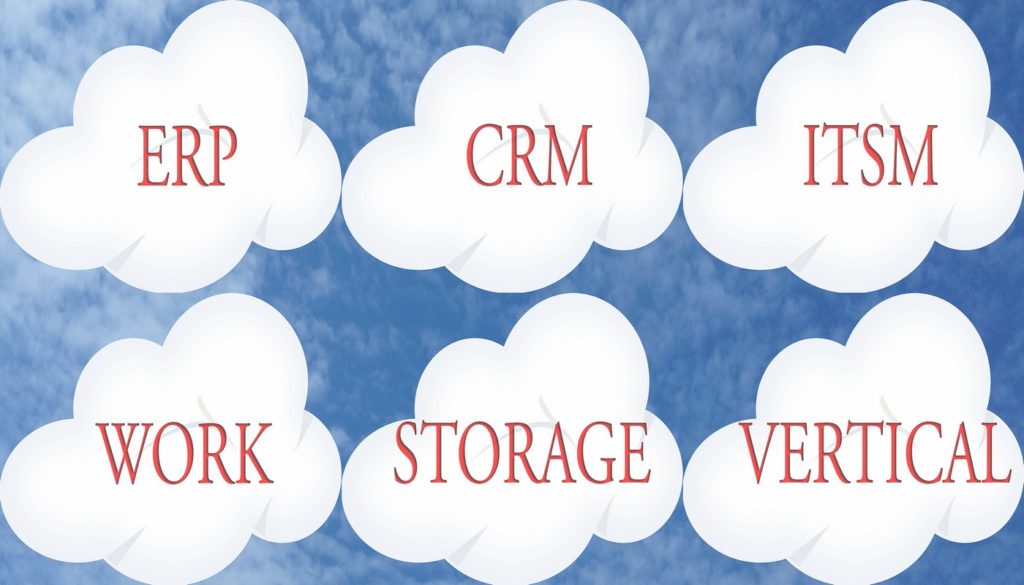
6 Clouds Essential for Every Business
No more than six years ago, businesses shied away from the “foolish” concept of shifting all their core applications, platforms and infrastructure to third parties. The idea of losing control of data, being dependent on other vendors for information security, and sharing resources with other enterprises seemed like trade-offs few would be willing to make. However, in a short time, the opinions of the masses have been reversed, with the foolish idea being not to leverage the new ways of doing business.
With the development of more advanced, safer solutions that have reduced risks in reliability, security, and data loss, while giving companies benefits that on premise solutions could not compete with, acceptance of running a business through third parties in other regions and countries grew rapidly. Today software as a service (SaaS) has become the norm, and not the exception. It provides clients with a myriad of benefits not previously available, including cost reductions via economies of scale, productivity, agility, scalability, protection, up-time, and more. Now the key question is not if to use the cloud, but what cloud solutions are needed to compete.
The answer is not black and white, but understanding the general SaaS enterprise application space is a great place to start. Here are six key areas that organizations should think about when it comes to an enterprise application strategy:
The Core Cloud (ERP):
Like it or not, every business must handle certain administrative duties on a daily basis. Keeping track of financial transactions, building a General Ledger, producing financial statements, managing payroll and resources, are all integral to an organization, whether a small business or a Fortune 500 organization. These administrative tasks are often similar from business to business, and outsourcing a system makes perfect sense because there may be little customization required, and it reduces the use of additional resources on non-business critical processes.
Vendors have worked to eliminate the need for multiple core systems by creating secure databases with all employee and financial information in one place. This eliminates data errors while allowing reporting and analysis to be more streamlined and complete. It also increases the return on investment by eliminating costs from redundant applications and administrative resources
Leading Vendors: Workday, Oracle, NetSuite, SAP
The Customer Cloud (CRM):
Today’s businesses require a customer relationship management (CRM) system that can provide every type of customer data, from demographic details to order histories, at a moment’s notice. The ability to have all of an organization’s client data available to every member of a sales team gives them an exponential advantage versus the old system of a disparate CRM systems stored on local computers that were inaccessible to all resources. A CRM application in the cloud can also leverage analytical data to anticipate customer desires based off of previous data.
The customer cloud is not just a sales tool. With social media now commonplace, the best solutions merge marketing materials through their SaaS applications with cross-channel strategies that include email, mobile, social and web-based campaigns. Company customer data can be combined with vendor data to reach the right audiences with the right messages.
Leading Vendors: Salesforce, Oracle, Microsoft, SAP
The Productivity Cloud (WORK):
Moving productivity suite applications to the cloud may make more sense than any of the other five clouds on this list. It allows for every member of an organization to automatically back-up their work, collaborate with others both internally and with third-party vendors, access productivity tools whenever, wherever they are through mobile applications that can work in both connected and offline states, and eliminate configuration and set-up time.
Now if that isn’t convincing enough, it may not matter. Industry leaders have nearly eliminated the option for businesses to NOT move to the cloud. They have done away with stand-alone products and made the same on-line tools much cheaper on a subscription basis. Microsoft’s Office 365 Suite and Adobe’s Creative Cloud Suite are both nearly 100% subscription based on-line tools. Sure these applications have local components that allow for work off-line, but they are designed for network access.
Leading Vendors: Microsoft, Adobe, Google
The Storage Cloud:
By now most consumers know the advantages of storing documents, photos and music in the cloud. It offers an instant backup of precious memories, can be accessed anytime, and can extend your hard-drive when space is at a premium. Solutions such as Google Drive, Microsoft OneDrive, Box, Dropbox and Apple’s iCloud are commonplace. Businesses have similar needs, yet their priorities and requirement levels are much different. For example, if an individual loses their files, he or she may not lose millions of dollars if the recovery period is more than 24 hours.
Leading Vendors: Microsoft, Amazon, EMC, Google, Oracle, IBM
The IT Cloud (ITSM):
Information Technology Service Management (ITSM) solutions have quickly evolved from basic ticketing systems that dealt with technical issues from either employees or customers to a catch-all single system used to automate repetitive IT tasks, create efficiencies through self-service processes and help organizations run their full IT department. For example, with a cloud-based ITSM solution, an organization can track servers, laptops and other high-value assets around the globe, better estimating what will be needed and when. Incidents can be managed quicker as solutions can be instantaneously seen by all.
Leading Vendors: ServiceNow, Atlassian, Salesforce, Zendesk
The Vertical Cloud (INDUSTRY):
The majority of cloud vendors gain economies of scale by leveraging their application horizontally over many different industries. They build a product with strong functionality that can be configured for a retail firm, media organization or a public institution by modifying certain fields or modules. This works well in many cases since all businesses have similar needs such as HR, Finance, document management, basic presentation / spreadsheet functionality or IT support centers. Yet there are trade-offs some are not willing to accept; software can be configured only so much, and customized changes are usually prohibited with SaaS vendors. This is where the vertical cloud shines.
Vendors build the software for specific industries with unique needs. Manufacturing, energy, life sciences, or public organizations must run their businesses with different niche requirements than any other industry. The solutions go much deeper than any horizontal vendor because they don’t go for the one size fits all approach. These solutions don’t require organizations to find as many work-arounds in the software since the vendors understands the business processes and priorities that are specific for an industry.
Leading Vendors: Athena (Healthcare), Veeva Systems (Healthcare), Opower (Energy), Plex (Manufacturing), Rootstock (Manufacturing), Dealertrack (Transportation), Rocket Lawer (Legal)
Lines between these six types of clouds are blurry at best. Companies that are strong in some areas have expanded their offerings into other areas with various strategies.
Salesforce has expanded their products into a platform (PaaS) that allows for partners to fill the holes in their ecosystem, raising the value of both vendors. Other software companies such as Oracle are specializing software to meet the needs of each vertical market where it makes financial sense. Google will offer clients a storage and productivity solution as an all-in-one package.
In 2016 there will definitely be a large amount of consolidation as vendors look to be one-stop shops for their clients. For every CIO or CEO looking to select cloud-based applications that can scale with their business, he or she should make sure to understand the vendors’ strategies as well.
About the author: David Apollon is the managing director at 9Nation Inc., a consulting firm founded ten years ago to help Fortune 500 companies as well as growth-stage firms handle special IT and strategic projects including ERP, CRM and cloud-based implementations. David has led over 75 corporate programs, projects and PMO initiatives in the past 20 years.
